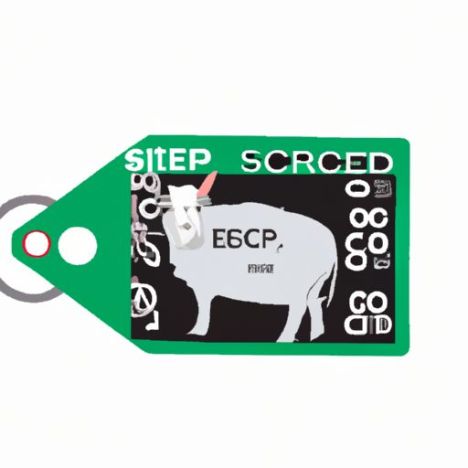Table of Contents
فوائد استخدام علامات الأذن RFID لإدارة الثروة الحيوانية
كيفية وضع علامات الأذن والحفاظ عليها بشكل صحيح للأغنام والماشية

تعد علامات الأذن أداة أساسية لإدارة الثروة الحيوانية، حيث توفر طريقة للتعرف على الحيوانات الفردية وتتبع صحتها وأدائها. يعد تطبيق علامات الأذن والحفاظ عليها بشكل صحيح أمرًا بالغ الأهمية لضمان حفظ السجلات الدقيقة والإدارة الفعالة للأغنام والماشية. سنناقش في هذه المقالة أهمية علامات الأذن، وكيفية تطبيقها بشكل صحيح، ونصائح للحفاظ عليها لضمان فعاليتها.
تأتي علامات الأذن في أشكال مختلفة، بما في ذلك العلامات المرئية، والعلامات الإلكترونية، وعلامات RFID. يخدم كل نوع غرضًا محددًا، حيث تعد علامات RFID هي الأكثر تقدمًا وكفاءة لتتبع وإدارة الماشية. بغض النظر عن نوع علامة الأذن التي تختارها، فإن التطبيق المناسب هو المفتاح لضمان بقائها في مكانها وإمكانية قراءتها.
عند وضع علامات الأذن، من المهم اختيار علامة الحجم المناسبة لأذن الحيوان. قد تصبح العلامات الصغيرة جدًا مدمجة في أنسجة الأذن، مما يسبب عدم الراحة واحتمال الإصابة بالعدوى. ومن ناحية أخرى، قد يتم تمزيق أو فقدان العلامات الكبيرة جدًا بسهولة. يوصى باستشارة طبيب بيطري أو خبير في إدارة الثروة الحيوانية لتحديد الحجم المناسب لحيواناتك.
قبل وضع علامة الأذن، تأكد من تقييد الحيوان بشكل صحيح لمنع إصابة كل من الحيوان والشخص الذي يضع العلامة. قم بتنظيف الأذن بمطهر لتقليل خطر العدوى، وتأكد من وضع العلامة بشكل صحيح في وسط الأذن للحصول على رؤية مثالية وسهولة القراءة.
بمجرد وضع علامة الأذن، من المهم فحصها وصيانتها بانتظام لضمان بقائها متصلة بشكل آمن. افحص البطاقة بحثًا عن أي علامات تآكل أو تلف، مثل بهتان اللون أو التشقق أو ارتخاء المرفقات. استبدل أي علامات تالفة على الفور لمنع فقدان الحيوان أو التعرف عليه بشكل خاطئ.
بالإضافة إلى الصيانة الدورية، من المهم الاحتفاظ بسجلات دقيقة لرقم علامة الأذن الخاصة بكل حيوان والمعلومات المقابلة لها، مثل السلالة والعمر والتاريخ الصحي. تعتبر هذه المعلومات ضرورية لتتبع أداء وصحة الحيوانات الفردية، وكذلك للامتثال للمتطلبات التنظيمية لتحديد هوية الماشية. . من خلال الاحتفاظ بسجلات دقيقة والتأكد من سلامة علامات الأذن، يمكنك تتبع أداء حيواناتك ومراقبة صحتها ورفاهيتها واتخاذ قرارات مستنيرة بشأن التربية والتغذية والرعاية الصحية. أداة قيمة لإدارة الثروة الحيوانية، وتوفير وسيلة لتحديد وتتبع الحيوانات الفردية لتحسين الإدارة والإنتاجية. يعد تطبيق علامات الأذن والحفاظ عليها بشكل صحيح أمرًا ضروريًا لضمان فعاليتها وموثوقيتها. باتباع الإرشادات الموضحة في هذه المقالة، يمكنك التأكد من وضع العلامات على الأغنام والماشية الخاصة بك وإدارتها بشكل صحيح لتحقيق الأداء الأمثل والصحة.
Ear tags are an essential tool for livestock management, providing a way to identify individual animals and track their health and performance. Properly applying and maintaining ear tags is crucial to ensure accurate record-keeping and efficient management of your sheep and cattle. In this article, we will discuss the importance of ear tags, how to properly apply them, and tips for maintaining them to ensure their effectiveness.
Ear tags come in various forms, including visual tags, electronic tags, and RFID tags. Each type serves a specific purpose, with RFID tags being the most advanced and efficient for tracking and managing livestock. Regardless of the type of Ear Tag you choose, proper application is key to ensuring they stay in place and remain readable.
When applying ear tags, it is important to choose the right size tag for the animal’s ear. Tags that are too small may become embedded in the ear tissue, causing discomfort and potential infection. On the other hand, tags that are too large may be easily torn out or lost. It is recommended to consult with a veterinarian or livestock management expert to determine the appropriate size for your animals.
Before applying the ear tag, make sure the animal is properly restrained to prevent injury to both the animal and the person applying the tag. Clean the ear with a disinfectant to reduce the risk of infection, and ensure the tag is properly positioned in the center of the ear for optimal visibility and readability.
Once the ear tag is applied, it is important to regularly check and maintain it to ensure it remains securely attached. Inspect the tag for any signs of wear or damage, such as fading, cracking, or loose attachments. Replace any damaged tags immediately to prevent loss or misidentification of the animal.
In addition to regular maintenance, it is important to keep accurate records of each animal’s ear tag number and corresponding information, such as breed, age, and health history. This information is essential for tracking the performance and health of individual animals, as well as for complying with regulatory requirements for livestock identification.
Properly applied and maintained ear tags not only help with individual animal identification but also contribute to overall herd management and productivity. By keeping accurate records and ensuring the integrity of ear tags, you can track the performance of your animals, monitor their health and well-being, and make informed decisions about breeding, feeding, and healthcare.
In conclusion, ear tags are a valuable tool for livestock management, providing a way to identify and track individual animals for improved management and productivity. Properly applying and maintaining ear tags is essential to ensure their effectiveness and reliability. By following the guidelines outlined in this article, you can ensure that your sheep and cattle are properly tagged and managed for optimal performance and health.

